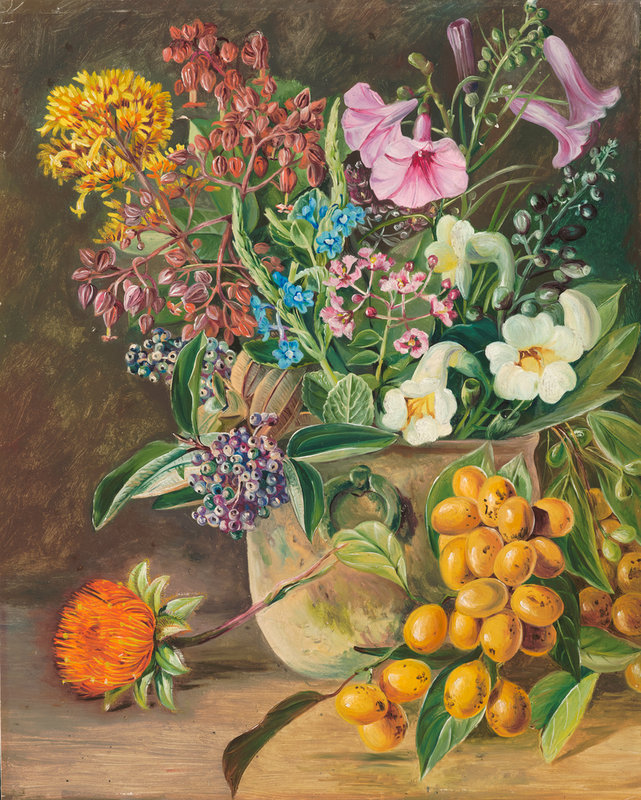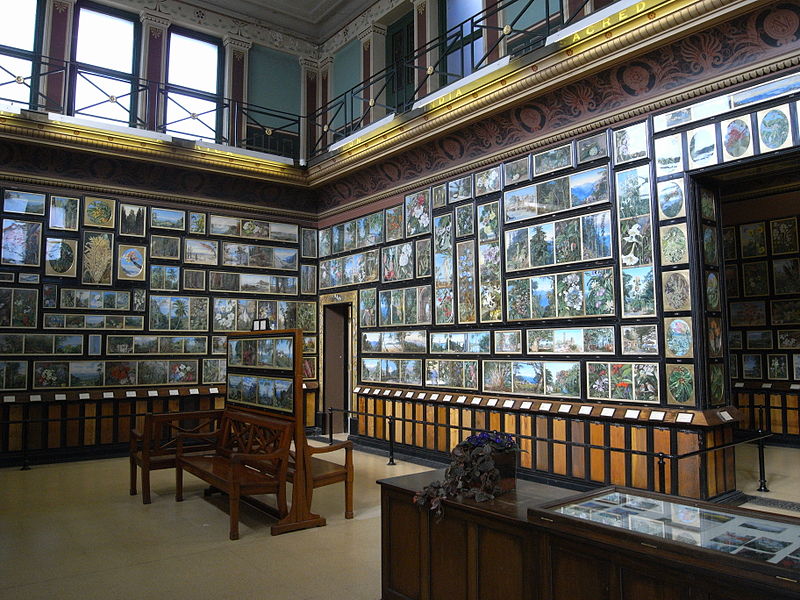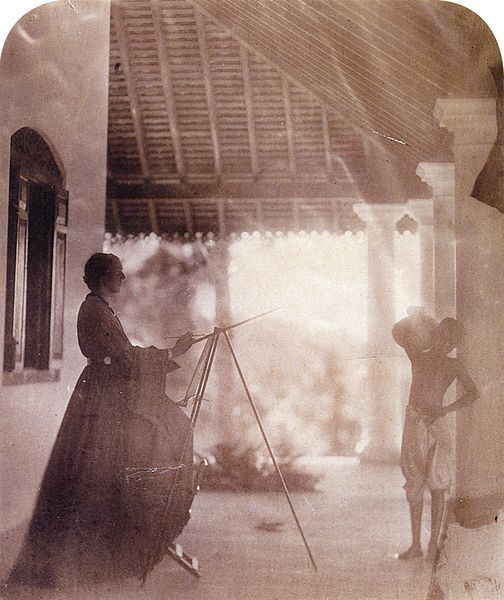Marianne North was an early female explorer, naturalist and painter. Her life, as she described it, was one of “wander and wonder and paint!” Her paintings are rendered with the vividness of colour and microscopic detail of the Pre-Raphaelite style. In her early recollections Marianne even longs for the tutelage of ‘old William Hunt.’
An excerpt from North’s journals, accompanied by a painting of the same scene, gives a sense of the emotional ecology at work in her art.

[View from the artist’s house on the Newcastle Road, Jamaica]
‘It almost took my breath away with its lovely fairy-like beauty; the very mist which always seemed to hang among the trees aim plants there made it the more lovely and mysterious. There were quantities of tree-ferns, and every other sort of fern, all growing piled on one another; trees with branches and stems quite covered with them … A close waxy pink was running up everything as well as the creeping fern, and many lycoodiums, mosses, and lichens. It was like a scene in a pantomime, too good to be real, the tree-fern fronds crossing and recrossing each other like network.’ [p. 50]
North looked after and travelled with her widowed father for much of her life. After his death in 1869, Marianne, financially independent at the age of forty, set off alone to explore and paint the world.
Her upbringing was curiously absent of much of the trappings of Victorian gender spheres and was ideal for the formative years of a future naturalist. Whilst reminiscing upon her childhood Marianne notes that ‘governesses hardly interfered with me in those days. Walter Scott or Shakespeare gave me their versions of history, and Robinson Crusoe and some other old books my ideas of geography.’ Her ‘garden was full of old-fashioned flowers [with] tiny paths and beds edged with box hedges, leading up to a quaint old pigeon-house covered with ivy, and beyond that was the park full of grand trees, and the church and village’. [p. 18]
During her artistic odyssey around the world Marianne displayed impressive grit and determination. Faced with numerous occasions where her gender was perceived as an obstacle to her pursuits Marianne proved impervious to derision. In Palermo, Italy, when her landlord ‘had a strong objection to travelling ladies, and always pretended he had no rooms for them, except on the fifth floor’ Marianne dauntlessly responded with ‘so to the fifth we went, and gained all the better view’. [p. 28]
Similarly, on a trip to the Niagara Falls North notes how ‘the Head Guide of the Falls, patronised me, and told me if I got chilled at any time just to go and ask his missus to give me a good cup of coffee, [as] it ‘ud do her heart good to make it for me’. However, un-phased Marianne settles down to work on the boulders below, between two huge roaring falls, and becomes the spectacle of the tourists who passed her by to look at her ‘at intervals’ in ‘suits of yellow oilskin’. [p. 36]
[An assortment of Marianne North’s paintings available at WikiPaintings.]
On her travels Marianne was often accompanied by a female chaperone. However, she was often vexed by her listless companion’s inability to keep up with her intrepid adventuring. In Southern Italy, fed up with ‘Elizabeth’s constant complaints and weariness’ which ‘ tire her out’ [p. 30] North took the steamer from Messina to Genoa and left both her apathetic attendant and her luggage at the inn. After her two day’s break for freedom she returned to Naples and picked up her trunks and Elizabeth, whom she put on a steamer to Genoa to be sent home.
Later on in her travels Marianne rather than be held back by a chaperone often ‘landed alone and friendless’ [p. 47] on an unknown shore despite ‘know[ing] nothing more trying to a shy person than landing for the first time among a strange people and language’. [p. 59.] Although she often found that ‘when the good people found my hobby for painting strange plants, they sent me all kinds of beautiful specimens.’ [p. 83]
Unlike other female naturalists her father’s wealth afforded Marianne the adequate means to rescue her work from obscurity. In 1882, a gallery of Marianne North’s work opened at England’s Royal Botanic Gardens at Kew. Funded by North, the gallery was designed by James Fergusson under her supervision – Marianne herself arranging the paintings and crafting the frieze and decorations surrounding the doors to the gallery. North’s eight hundred and thirty two paintings provided the scientists at Kew and the general public with both empirical and aesthetic pleasure – the scientific accuracy of North’s paintings even lead to four plant species being named after her.
North’s unique style departed from the tradition of sketching a watercolour flower individuated onto a plain background – instead her paintings are rendered in vivid detail each brushstroke capturing her botanical specimens in their own immediate, thriving microcosm. At a time when photographs remained in black and white North’s emotive works of colour must have been a kaleidoscopic sight to behold. William Blunt in The Art of Botanical Illustration (1950) describes North’s gallery as ‘like a gigantic botanical postage-stamp album [where] yet further flowers scramble up the doorposts and across the lintels.’
Marianne North’s most famous supporter was Charles Darwin, the English naturalist whose meticulous observations became the foundation of evolutionary biology. In 1880 North was ‘asked by Mrs Lichfield to come and meet her father, Charles Darwin, who wanted to see me, but could not climb my stairs.’ North refers to Darwin as ‘the greatest man living, the most truthful, as well as the most unselfish and modest, [for] he was always trying to give others rather than himself the credit of his own great thoughts and work.’ [p. 151] Darwin’s ‘ power of bringing out other people’s best points’ extended to Marianne whom he advised to see and paint the Australian vegetation ‘which was unlike that of any other country’. North, taking Darwin’s advice as ‘a royal command’, went ‘at once’ and eagerly returned to Down house in 1881 to sit with Darwin and his children under a shady tree to inspect her paintings together. According to North, Darwin showed in ‘a few words how much more he knew about the subjects than anyone else, myself included, though I had seen them and he had not.’ Such was the intimacy of their mutual accord, that when North was readying to depart Darwin ‘insisted on packing [her] sketches and putting them even into the carriage with his own hands.’ [p. 197]
Darwin sent Marianne a short note after this visit to show his appreciation of her work and friendship.
2nd August 1881 My Dear Miss North, – I am much obliged for the “Australian Sheep,” which is very curious. If I had I seen it from a yard’s distance lying on a table, I would have wagered that it was a coral of the genus Porites.
I am so glad that I have seen your Australian pictures, and it was extremely kind of you to bring call up with considerable vividness scenes in various countries which I have seen, and it is no various countries which I have seen, and it is no small pleasure; but my mind in this respect must be a mere barren waste compared with your mind. I remain, dear Miss North, yours, truly obliged, CHARLES DARWIN
According to Kew Garden’s Marianne North’s gallery is, to this day, “the only permanent solo exhibition by a female artist in Britain”. Natural history, thus, in many ways, functioned in the Victorian era as an agent of liberation that had the capacity to free women like Marianne North from the trappings of restrictive femininity.
A small sample of Marianne North’s botanical art is available via WikiPaintings.
All references to North’s recollections are from Marianne North, A Vision of Eden: The Life and Works of Marianne North (United Kingdom: Webb & Bower / The Royal Botanic Gardens, Kew, 1980).
To be kept up to date on new posts from The Cabinet of Curiosity subscribe by WordPress or follow me on Twitter @rosalindmwhite.










camilledefleurville says:
Simply stunning. Thank you.
studioleoninarte says:
Thank you for letting me know such a fascinating artist I never heard of!
The Curiosity Cabinet says:
my pleasure!
The Curiosity Cabinet says:
Thank YOU – for being the very first comment on my first ever blog post!
camilledefleurville says:
I did not know this! Your blog was spotted by a friend of mine who thought I would be interested. We both posted the link on our respective FB page and I reposted it as well. Your blog will be a great success! 🙂
Alizee says:
Fascinating story! Thank you for sharing it X
Rosalind White says:
I’m glad you enjoyed it!
artandarchitecturemainly says:
Just because a woman is very talented, it doesn’t necessarily mean she will do well. Marianne North was fortunate that a] Charles Darwin was a close friend of old Mr North and b] Darwin encouraged Marianne to travel to Australia and New Zealand, to paint Antipodean native plants in oils. Right place at the right time!